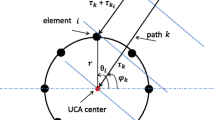Abstract
This paper presents the results of widebandmeasurements of an indoor wireless radio channel at 1.8GHz. Propagation measurements were carried out in anindoor environment at the Technical University of Athens with a network analyzer. From themeasured impulse response (IR) profiles collected, meanexcess delay tau and root mean square of delay spreadtau Statistical analysis of delay spread and amplitude fading has been performed. Comparison withsimulation results extracted from SIRCIM Simulatorpackage has also been made. have beenestimated.
Similar content being viewed by others
REFERENCES
G. L. Turin, A statistical model of urban multipath propagation, IEEE Transactions on Vehicular Technology, Vol. 21, pp. 1–9, February 1972.
H. Hashemi and D. Tholl, Statistical modelling and simulation of the RMS delay spread of indoor radio propagation channels, IEEE Transactions on Vehicular Technology, Vol. 43,No. 1, February 1994.
K. Pahlavan and S. J. Howard, Frequency domain measurements of indoor radio channels, Electronics Letters, Vol. 25, pp. 1645–1647, 1989.
H. Nikookar and H. Hashemi, Statistical modelling of amplitude fading of indoor radio propagation channels. In Proceedings of 2nd International Conference on Universal Personal Communications, Ottawa, Canada, Vol. 1, pp. 84–88, 1993.
T. S. Rappaport, S. Y. Seidel, P. M. Koushik, and L. McCulley, SIRCIM: Simulation of Indoor Radio Impulse Response Models, Version 2.0, April 1992.
H. Zaghloul, G. Morrison, and M. Fattouche, Frequency response and path loss measurements of indoor channel, Electronics Letters, Vol. 27, pp. 1021–1023, 1991.
Peter Carlson and Lars Olsson, Time dispersion measurement system for radio propagation at 1800 MHz and results from typical indoorenvironments. In Proceedings of 44th Vehicular Technology Conference, Stockholm, Sweden, 1994.
T. A. Sexton and K. Pahlavan, Channel modelling and adaptive equalisation of indoor channels, IEEE Journal on Selected Areas in Communication, Vol. JSAC-5, pp. 128–137, February 1987.
S. Howard and K. Pahlavan, Measurement s and analysis of the indoor radio channel in the frequency domain, IEEE Transact ions on Instrumentation and Measurements, Vol. IM-38, pp. 751–755, October 1990.
T. S. Rappaport, Characterisation of UHF multipath radio channels in factory buildings, IEEE Transactions on Antennas and Propagation, Vol. 37,No. 8, pp. 1058–1069, August 1989.
F. J. Harris, On the use of windows for harmonic analysis with the discrete Fourier transform, Proceedings of the IEE, Vol. 66,No. 1, January 1978.
Rights and permissions
About this article
Cite this article
Papadakis, N., Hatziefremidis, A., Tserolas, A. et al. Wideband Propagation Indoor Environment Measurements and Modeling in. International Journal of Wireless Information Networks 4, 101–111 (1997). https://doi.org/10.1023/A:1018889807413
Issue Date:
DOI: https://doi.org/10.1023/A:1018889807413




